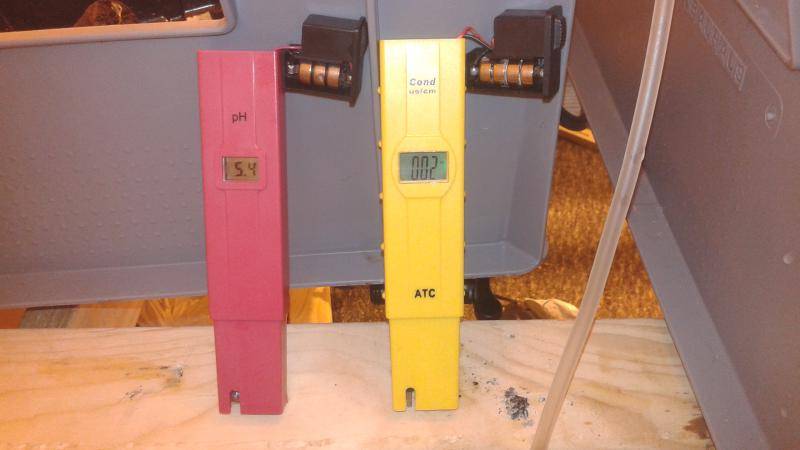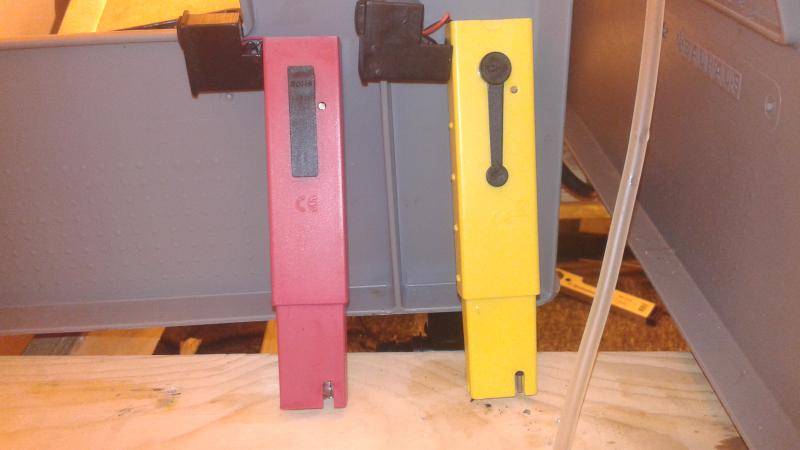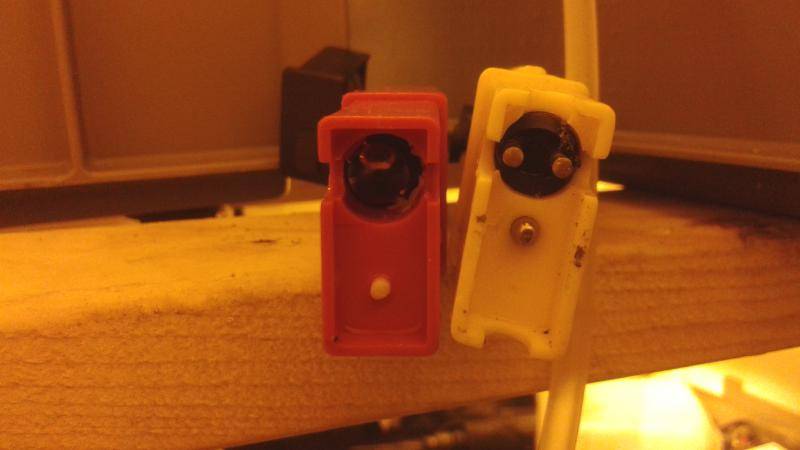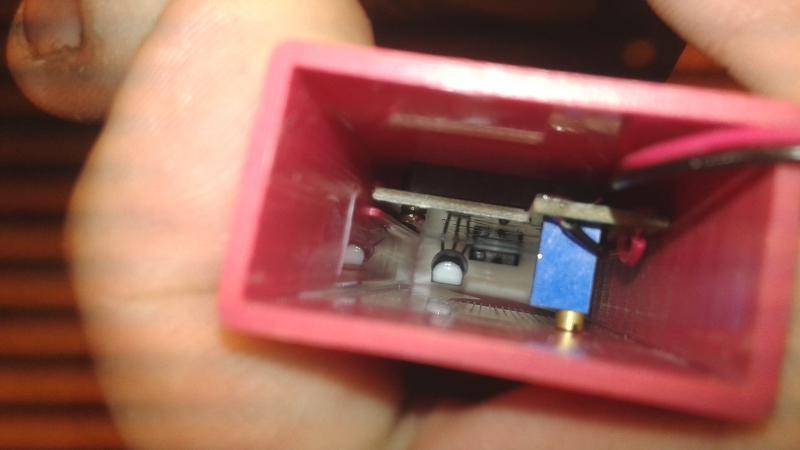...Costs from ~€10<. Anyway, since I bought these as a kit, and that they're almost identical in construction, you can see this as a review for both the pH, and the EC-meter. These digital meters are usually called "Budget *meter", when marketed, no real brand. Some resellers have stamped their own name on them. It's the same construct altogether though.
Been using these now for almost three weeks. No problems what so ever. It seems to be "no name"-meters, since googeling doesn't help me find the "brand". Called "budget" in most places its sold. And it really is budget, but it's also all you really need.(..and _nothing_ more.)
It's the probe, and a minimal circuit board with a display mounted in a plain plastic tube. Both top and bottom seals are completely airtight. It is convenient to fill the lid with the really small volume storing solution needed for immersing the probe. Then put the lid on, and storing it like that. Strangely enough they feel kinda quality even being this simple. Anyhow I see it as a plus, cause there are fewer components that can break. Also, the plastic is sturdy. I've already dropped mine in the floor a few times. A hit though, or even a scratch directly on the pH-probe/glass"bulb" would surely brake it. But that probably is true with other meter brands. Luckily the probe tip is a little built in, so that it is protected from most objects.
User wise there are only two interactions possible on both meters. On/off, and the potentiometer screw on the back. The potentiometer is turned to adjust the displayed value if necessary after calibration.The screw is not possible to turn by mistake, and not sensitive, making it easy to set to the right value.
For some reason the EC-meter got a slightly bigger display with a back light.
I bought my meters for 10£/meter, which they definitely are worth. When I've googled around though I generally see much higher prices, seems to be a price range as wide as from 10-55€. These should not cost more than ~€20/piece. They're definitely NOT worth that much.
Both meters came preloaded with batteries, in a transparent case with a screwdriver and a manual. The pH-meter also had a pH 7.01 buffer sachet.
So far I really like these. I've noticed a BIG risk thou. There is no extra tightening around the adjustment/potentiometer screw on the back. it's just a whole in the plastic the size of the screw, which around there is no extra tightening. If the meter were immersed in water it would probably leak some into the electronics. I guess even a good splash could make it moist in there. I know I'm gonna get a piece of suitable tape or something to cover it between adjustments to be sure. If I find one small enough of these "dry-bags," shipped with some electronics, it'll definitely be put inside as well, just to be sure.
Apart from this potential risk(Which isn't a risk if you're aware/take precautions). This is really GREAT value for your money, if all you need is a digital meter to take repeated readings now and then. I highly recommend, what other functions are really worth paying for? These kind of pH-probes usually "lasts for 1½-2 years, if you take care of them properly". The EC-probes are almost indestructible though. The pH-probes however should _never_ be allowed to get dry. That can cause future readings becoming more unreliable. They should also be stored in something as similar to what's inside the bulb as possible, aka storing-solution. Buffer-solution is pretty OK, only thing you should really avoid is distilled/RO-water, even if it may "feel" pure/clean. This might not be the whole world, but it _will_ shorten the probe lifespan, but by how much, I have no idea.
Front, back..


Underside, and top-under lid


Been using these now for almost three weeks. No problems what so ever. It seems to be "no name"-meters, since googeling doesn't help me find the "brand". Called "budget" in most places its sold. And it really is budget, but it's also all you really need.(..and _nothing_ more.)
It's the probe, and a minimal circuit board with a display mounted in a plain plastic tube. Both top and bottom seals are completely airtight. It is convenient to fill the lid with the really small volume storing solution needed for immersing the probe. Then put the lid on, and storing it like that. Strangely enough they feel kinda quality even being this simple. Anyhow I see it as a plus, cause there are fewer components that can break. Also, the plastic is sturdy. I've already dropped mine in the floor a few times. A hit though, or even a scratch directly on the pH-probe/glass"bulb" would surely brake it. But that probably is true with other meter brands. Luckily the probe tip is a little built in, so that it is protected from most objects.
User wise there are only two interactions possible on both meters. On/off, and the potentiometer screw on the back. The potentiometer is turned to adjust the displayed value if necessary after calibration.The screw is not possible to turn by mistake, and not sensitive, making it easy to set to the right value.
For some reason the EC-meter got a slightly bigger display with a back light.
I bought my meters for 10£/meter, which they definitely are worth. When I've googled around though I generally see much higher prices, seems to be a price range as wide as from 10-55€. These should not cost more than ~€20/piece. They're definitely NOT worth that much.
Both meters came preloaded with batteries, in a transparent case with a screwdriver and a manual. The pH-meter also had a pH 7.01 buffer sachet.
So far I really like these. I've noticed a BIG risk thou. There is no extra tightening around the adjustment/potentiometer screw on the back. it's just a whole in the plastic the size of the screw, which around there is no extra tightening. If the meter were immersed in water it would probably leak some into the electronics. I guess even a good splash could make it moist in there. I know I'm gonna get a piece of suitable tape or something to cover it between adjustments to be sure. If I find one small enough of these "dry-bags," shipped with some electronics, it'll definitely be put inside as well, just to be sure.
Apart from this potential risk(Which isn't a risk if you're aware/take precautions). This is really GREAT value for your money, if all you need is a digital meter to take repeated readings now and then. I highly recommend, what other functions are really worth paying for? These kind of pH-probes usually "lasts for 1½-2 years, if you take care of them properly". The EC-probes are almost indestructible though. The pH-probes however should _never_ be allowed to get dry. That can cause future readings becoming more unreliable. They should also be stored in something as similar to what's inside the bulb as possible, aka storing-solution. Buffer-solution is pretty OK, only thing you should really avoid is distilled/RO-water, even if it may "feel" pure/clean. This might not be the whole world, but it _will_ shorten the probe lifespan, but by how much, I have no idea.
Front, back..
Underside, and top-under lid


